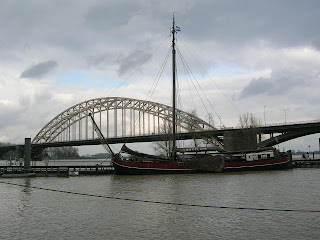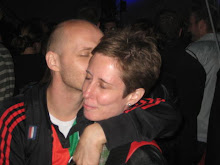Oh, and yesterday...
...Jeroen and I both had a free day so we visited the Nationaal Bevrijdingsmuseum (Liberation Museum) in Groesbeek, a short drive through rolling green hills from Nijmegen. Yes, we are lucky enough to live in one of the hilliest parts of the country!
This whole area played a major role during WWII, when Nijmegen was pretty much a frontline city. A major allied offensive against the Germans, known as Operation Market Garden, was launched here during September 1944 when they attempted, through a combination of massive numbers of airborne forces (paratroopers) and ground forces, to recapture a series of bridges in the hope they could then cross over the Rhine into Germany. The whole operation lasted 9 days, about 10,000 allied troops and 2,000 German troops were killed in action, and in the end the offensive was a failure, with the bridge over the Rhine (at Arnhem) proving to be the "bridge too far". If any of you have ever seen the movie "A Bridge Too Far" you will know what I am talking about!
 In the photo to the left you can see British tanks crossing the bridge here in Nijmegen during its successful recapture!
In the photo to the left you can see British tanks crossing the bridge here in Nijmegen during its successful recapture!The museum itself was REALLY interesting and had different sections focussing on different periods of the 1930s/40s/50s. It was designed to lead you on a chronological journey - setting the scene with an explanation of the rise of Nazism/Facism, moving onto the German invasion & occupation of NL, the liberation, and later the reconstruction of the country after the war.
The most moving exhibits for me were those focussing on the lives of ordinary people during the occupation. At first it seems people just tried to adapt to the occupation and get on with life as normally as possible. But as time passed and resistance grew, life got increasingly difficult. People went into hiding; of the 140,000 Jewish people living in NL prior to 1940 only 30,000 survived the war; and during the winter here of 1944-45 (known as the Hunger Winter) over 20,000 people died of starvation or malnutrition! In search of food people often walked for tens of kilometres to trade valuables for food at farms; tulip bulbs & sugarbeets were commonly eaten; and furniture & houses were dismantled to provide fuel for heating.
Throughout the museum there were recreations of things such as the secret cupboards people would sit in to listen to illegal radio broadcasts of the BBC and Radio Orange from London, and of the air raid shelters people created in their own cellars. And last, but definately not least, there was a moving memorial to all those who died in battles around this area. Countless allied troops (American, Polish, Canadian and British) were listed as being killed in and around Nijmegen, Arnhem and Groesbeek. We even saw some soldiers' names listed as being killed during battles on streets just around the corner from our own house here! Such a surreal and sad feeling.
I also think I have a bit more of an insight into and understanding of the sort of hardships my Mum and Dad (as young children on opposing sides of the conflict!) must have experienced.
Alli xxx










.jpg)
.jpg)


